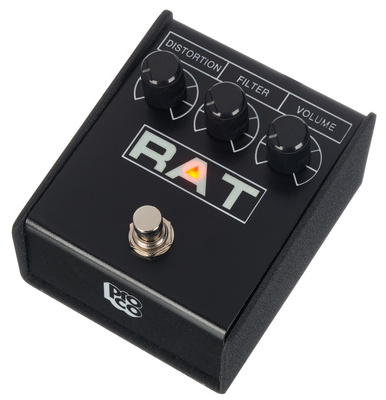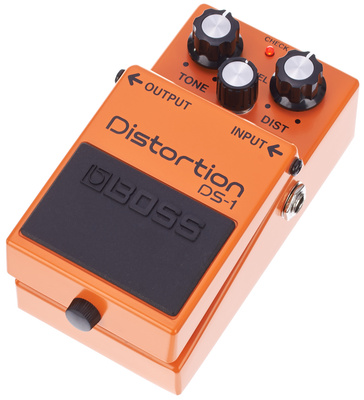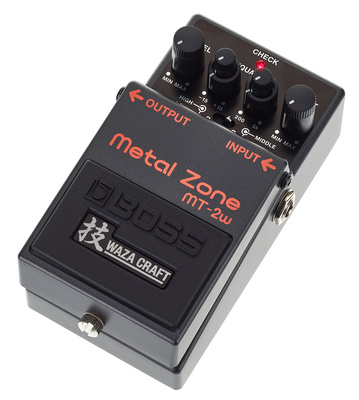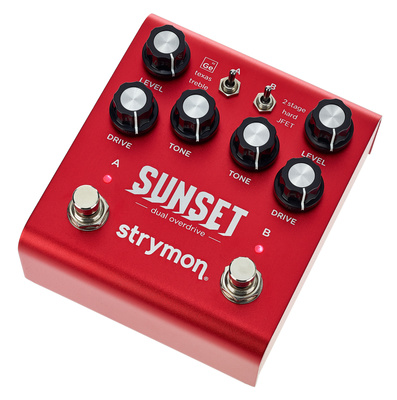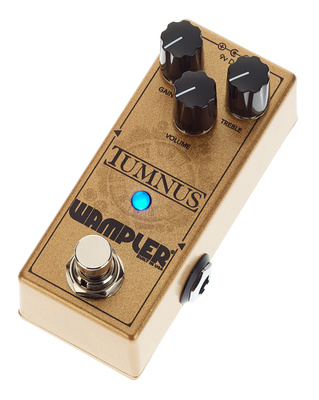The five best distortion/overdrive pedals
Whether or not you need a distortion pedal as a beginner guitarist depends primarily on the style of music you want to play. For most guitarists, a distortion or overdrive pedal is an essential addition to their pedalboard. Read on to find out exactly what the difference is between distortion and overdrive, and what distortion pedals are actually good for. You'll also find out which distortion pedals made it into our top 5 in this article.
Why do you need a distortion pedal?
The distorted guitar sound is a defining feature of many popular genres, such as hard rock and metal. However, slight distortion of the guitar sound is also used in other genres, such as blues. Distortion generally makes your sound more aggressive and assertive.
Originally, distortion was a noise that occurred in amplifiers when they were played very loudly. This phenomenon is called 'clipping' in technical jargon. If you imagine the typical waveform of a sound, clipping means that the peaks are so high that they are cut off.
As it is not practical to play amplifiers at such high volumes, distortion was soon recreated as an effect. This means that you can now use distortion without damaging your hearing or disturbing the neighbourhood.
Many amplifiers have two channels: one undistorted and one distorted. You can achieve greater flexibility with external distortion or overdrive pedals. Other terms for distortion include 'screamer' and 'fuzz', which can also be found in the brand or product names of some pedals.
Two absolute classics among distortion pedals are the ProCo Rat* distortion pedal and the Ibanez TS808*, which is responsible for the overdrive effect on countless albums.
But what is the difference between distortion and overdrive?
As mentioned previously, the characteristic distortion sound is created by clipping, i.e. cutting off the sound peaks. There are two types of clipping: hard and soft. With hard clipping, the sound peaks are smoothed out across the board. With soft clipping, however, this only kicks in above a certain threshold, gently flattening the waveform instead of cutting it off completely at the peak.
The difference between overdrive and distortion is simply whether hard or soft clipping is used. Distortion uses hard clipping and overdrive uses soft clipping.
In terms of sound, this means that distortion sounds much more aggressive. This is why distortion pedals are especially popular in rock and metal. Overdrive doesn't distort the sound as much, but it can be used more dynamically and is better suited to more 'emotional' music styles, such as blues or jazz.
Using an overdrive pedal won't produce a powerful, loud sound; instead, you can play quiet passages essentially without distortion. Only when you strike the strings harder will the distortion kick in. With a distortion pedal, however, it almost doesn't matter how gently or powerfully you strike the strings; distortion will occur either way.
As the two effects are similar in principle, some pedals can be used as either an overdrive or a distortion pedal, depending on the setting.
Distortion and overdrive: our 5 current favourites
Want to buy a distortion or overdrive pedal? Then you've come to the right place. Here, we present our five favourite distortion pedals. As with all our lists of favourite classic effects pedals, these are not necessarily the best-sounding devices on the market. Instead, we have focused on devices in different price ranges and those that offer interesting additional features.
ProCo Rat 2
What do Kurt Cobain of Nirvana and James Hetfield of Metallica have in common? The answer: they both used the ProCo Rat for distortion. The ProCo Rat 2 is a modern update of the classic distortion pedal that has been a permanent fixture on many pedalboards since the late 1970s.
The pedal comes in an inconspicuous black case that looks slightly outdated. While the device may lack visual appeal, it more than makes up for this with its sound. For the affordable price of around £75, the Rat provides a sound that is popular with professionals and offers plenty of gain and true bypass.
The ProCo Rat can be powered by either a 9-volt battery or a suitable power supply, which is not included. With only three knobs for distortion, filter and volume, the ProCo Rat is incredibly easy to operate.
Boss DS-1
Another representative of the 'distortion' genre is the DS-1 from Boss. Available for just under £70, the DS-1 is something of a classic among distortion pedals thanks to its widespread use by bands in the '90s and early 2000s.
It is very easy to use, with three knobs for tone, level and distortion. As usual, the device comes in Boss's iconic pedal format, which, in this case, is painted orange and features the company's characteristic large foot switch.
Although the DS-1 is the cheapest device on our list, you don't have to worry about it sounding cheap. It offers fantastic value for money and, apart from slightly shallow mids, has no real weak points. We believe that the DS-1 is one of the best distortion pedals for beginners.
The DS-1 can be powered by a 9-volt battery or via an optional power supply unit.
Boss MT-2w Metal Zone
Is metal your passion? Then the Metal Zone distortion pedal from Boss is just what you need. As the name suggests, the Metal Zone is not a pedal for everyone, but has been specially developed for fans of merciless distortion.
If you have read some of our reviews of multi-effects devices, you will be familiar with the name Metal Zone, as most multi-effects devices have a Metal Zone simulation – and not just those from Boss. This is no surprise, as the Boss pedal is extremely popular in the metal sector for good reason.
The Metal Zone is based on a circuit in which the input signal is distorted twice, resulting in a significantly fatter sound. However, it's not just the hardness of the sound that impresses us about the MT-2w. The pedal has good sustain and is therefore ideal for both sophisticated solos and brutal riffs.
The device's housing follows Boss's well-established design and is painted jet black with blood-red lettering, fitting for the genre. As well as conventional level and distortion knobs, Boss has equipped its pedal with two special knobs featuring an outer ring that allow you to adjust the treble, bass, midrange and centre frequency.
At around £140, the MT-2w is more expensive than other Boss products. Nevertheless, if you're a metal guitarist, you can't go wrong with this pedal, even at this price.
Incidentally, the ‘W’ in the product name indicates that this is a device from the Waza series. Waza is a Japanese word meaning 'technique' or 'art'. Devices in the Waza series are manufactured directly by Boss in Japan and have a switch that allows you to switch between two channels.
With the MT-2W, the standard setting provides the classic Metal Zone sound, while the custom setting offers the new, improved Waza sound, which significantly enhances the device's dynamics.
Strymon Sunset
The Strymon Sunset is the first overdrive device to make our list of favourites. With a price tag of just over £250, it is clearly aimed more at professionals. What makes this device special is that it combines analogue and digital sound worlds. In this case, 'digital' means that a powerful Sharc DSP chip has been installed.
Incidentally, the six knobs on its stylish red housing serve a purpose. This pedal offers incredible sonic versatility. The interface is divided into A and B sections. The A sound is similar to the Ibanez Tube Screamer, while the B sound is more reminiscent of the ProCo Rat. With the Sunset, however, these two sections are not mutually exclusive – they can also be combined, opening up some really interesting possibilities.
You can load and save presets on the device using an optional cable. A 9-volt power supply is included, as you would expect at this price point. Speaking of price, it may seem high at first. However, we believe that the Strymon device's great flexibility is more than worth the money.
Wampler Tumnus V2
The world of distortion pedals boasts many legendary devices that are well-known and favoured by professionals. The Klon Centaur is one such pedal in the overdrive category. But why are we telling you this when we're writing about the Wampler Tumnus? Because the Tumnus is a clone of the Klon Centaur – and a damn good one at that.
The Klon Centaur has one major drawback: it hasn't been produced for many years. Unless you have £1,500 to spare and the device is miraculously available on eBay, you'll have to make do with a clone, such as the Wampler Tumnus.
Not only does the Wampler Tumnus imitate the Centaur perfectly, it also looks stylish and has an ultra-compact housing. With only three knobs for gain, volume and treble, the Tumnus is easy to use.
The Centaur sound is certainly not for everyone. However, if you like it, the Tumnus is, in our opinion, the best way to get a device that comes very close to the original Centaur, with its price tag of 'only' just under £150. And you won't have to sell one of your kidneys on the black market to afford it.
Conclusion
A distortion pedal is an essential addition to almost every electric guitarist's pedalboard. If you're into hard rock and metal, a distortion pedal is the best option for you. Everyone else is probably better off with a good overdrive pedal.
